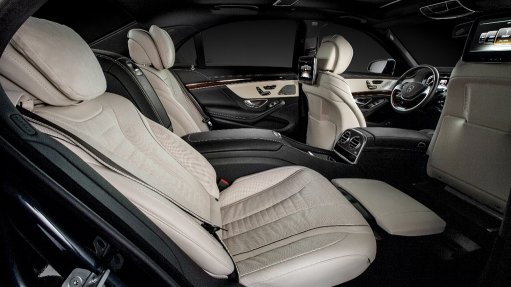
LAP OF LUXURY The many safety and ride-comfort technology features explain why the S-Class is often used as a chauffeur-driven vehicle
Mercedes-Benz South Africa (MBSA) president and CEO Dr Martin Zimmermann describes the new S-Class as “a special place to be”, with the car creating a sense of “wellness” once you are seated inside the German brand’s flagship model.
It is difficult to argue the matter, as the new S-Class indeed offers a long list of luxury elements and new technologies that should please driver and passenger alike.
Daimler, MBSA’s German parent company, sold more than 500 000 units of the previous-generation S-Class worldwide, and has received 30 000 preorders for the new model already.
In South Africa, MBSA sold 28 S-Class vehicles in October this year, and 13 in October 2011.
While South Africa’s Cabinet ministers may no longer acquire the S-Class as their official vehicles – should Finance Minister Pravin Gordhan’s austerity measures hold true – other high-flying locals may still do so, with the starting price a cool R1.214-million, and with the range currently topping out at R2.174-million for the S 63 AMG.
The second quarter of 2014 should up this last number, with the introduction of the S 600 and S 65 AMG.
The current S-Class line-up includes the S 400 Hybrid, the S 500 and the S 350 BlueTEC, as well as the S 400 HYBRID and S 500 long-wheel-base variants.
Fuel consumption has been lowered by up to 20%, compared with the outgoing model series, says Zimmermann, in part, owing to the S-Class slimming down by roughly 100 kg, with half of the body now made of aluminium.
The bottom-of-the-range S 350 BlueTEC diesel model claims, for example, fuel consumption of 5.5 ℓ/100 km, while it delivers 620 Nm of torque at 1 600 rpm to 2 400 rpm, speeding from zero to a hundred in 6.8 seconds. (The S 63 AMG can attain this speed in 4.4 seconds.)
The new S-Class offers a lot for its price tag, as one would expect, with the top-of-the-range vehicle available with individual rear seats that can recline 44º; a choice of six seat massage programmes; ionised air inside the vehi- cle; four different in-vehicle fragrances; an entertainment system for each seat in the back; WiFi access, with the vehicle acting as a WiFi hot spot; thermo cupholders; heated armrests; and a choice of seven colours for ambience lighting inside the vehicle.
The S-Class is also the first-ever car without a single light bulb, says Zimmermann. Mercedes-Benz is switching to light- emitting diode (LED) technology, and almost five hundred S-Class LEDs illuminate the road, the vehicle, the interior and the boot.
The array of safety and ride-comfort technology explains why the S-Class is often used as a chauffeur-driven vehicle. Whereas in Europe and North America the owner of an S-Class can frequently be found behind the wheel, it is mostly a chauffeur-driven vehicle in Asia.
One of its high-tech systems, Magic Body Control, allows the suspension on some of the S-Class models to adapt to the road surface. The vehicle sees roughly 150 m ahead, by means of a three-dimensional camera, and the Magic Body Control system then adjusts the suspension to deal with obstacles such as potholes or rough, uneven surfaces.
It can be compared to a duck gliding over water, but paddling like crazy underneath the surface.
Another high-tech system is Night View Assist Plus, which makes use of a thermal imaging camera.
It alerts the driver to the potential danger posed by pedestrians or animals in unlit areas in front of the vehicle by automatically switching the view of the speedometer to a crystal-clear night view image, highlighting the sources of danger.
A flashing spotlight indicates any pedestrians detected ahead.
This attracts the driver’s attention to the source of the danger, while also warning the person on the side of the road that the vehicle is approaching.
Other safety systems on the S-Class help the driver brake in time, stay in his or her lane, park the vehicle and stay alert while driving.
An inflatable seat belt strap aims to lower the risk of injury to rear passengers during an accident by reducing the loads acting on the ribcage. Should the crash sensors detect a severe frontal impact, the airbag control unit will trigger deployment and inflation of the beltbag.
A gas generator then inflates the multi- layered belt strap with Velcro seams to nearly three times its normal width. The larger surface area is able to better distribute the force acting on the passenger, thereby reducing the risk of injury.
As with all Mercedes-Benz passenger cars, the new S-Class comes standard with the PremiumDrive six-year/100 000 km maintenance plan, with no customer contribution required.